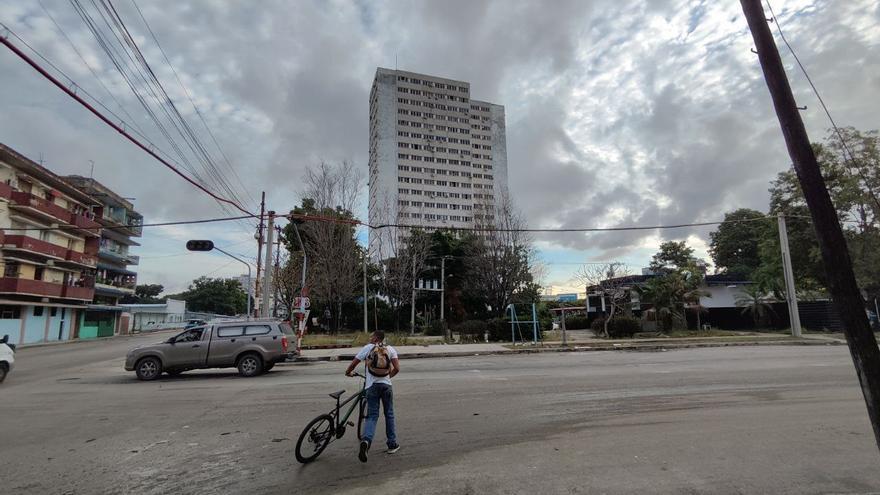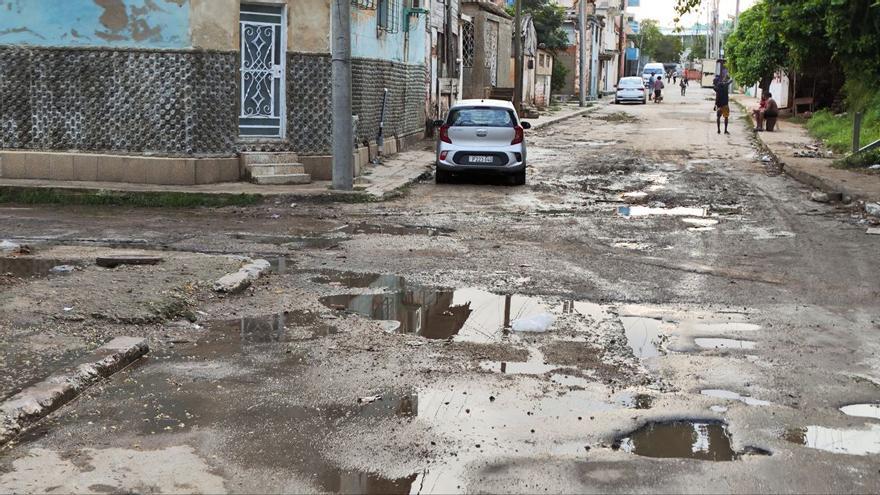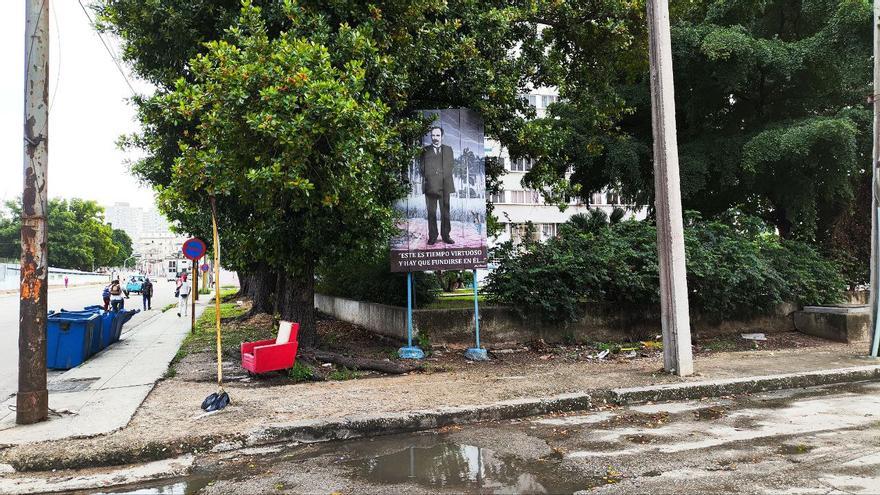
![]() 14ymedio, Natalia López Moya, Havana, 14 December 2023 — A quick touch with the index finger and middle finger on the shoulder is the key to knowing that the building known as Fama y Aplausos (Fame and Applause), on the corner of Infanta and Manglar in Havana, is the home of important official spokespeople who handed out national awards of various categories to figures who stood out during the ideological offensive at the beginning of this century: the Battle of Ideas.
14ymedio, Natalia López Moya, Havana, 14 December 2023 — A quick touch with the index finger and middle finger on the shoulder is the key to knowing that the building known as Fama y Aplausos (Fame and Applause), on the corner of Infanta and Manglar in Havana, is the home of important official spokespeople who handed out national awards of various categories to figures who stood out during the ideological offensive at the beginning of this century: the Battle of Ideas.
“This is no longer what it was, nor does it look like it did when I moved here,” a plastic artist who has lived in the place since its inauguration and prefers anonymity tells 14ymedio. “Not only has the entire building deteriorated, the area, which was always a little controversial because of the neighborhoods nearby, has become very dangerous. At night no one goes out or receives visitors. They lift weights.”
A tour of the surroundings is enough to see the mountains of filth, the streets full of potholes, the peeling walls and the dirty perimeter wall with cracks. On a corner, a poster with an image of José Martí highlights one of his phrases: “This is a virtuous time and you have to melt into it.” A few meters from the exterior gardens of the building, there are only mud and weeds left.

The nearby Pan-American store that even attracted residents of other neighborhoods for its “good assortment” is now a place that only sells products for the so-called ’released module’ — that is food and other items sold outside the ration system — as 14ymedio was able to verify this Wednesday. A bored custodian still remains in Fama y Aplausos, a remnant of the old team that guarded the place.
But the current description is far from what the 20-story building looked like two decades ago. Immaculate corridors, elevators that were quickly repaired when they broke, a reception area on the ground floor that made the visitor give chapter and verse about the person he was visiting, lights on the outside and an immaculate white paint on the facade stoked the curiosity of nearby neighbors.
Randy Alonso, director of Cubadebate, and Rosa Miriam Elizalde, main spokesperson for the media war against the independent press, were among the beneficiaries of an apartment in the building. They were chosen to receive the award for flattering, putting on makeup and lying. Of those “illustrious” inhabitants there are hardly any left, because they passed “to a better life” and now enjoy independent houses in more select neighborhoods.
Among the current residents, of course, there are figures of the plastic arts, outstanding filmmakers, troubadours who have supported with their music many political acts they were called to support. For them, however, the Infanta y Manglar building is not the same place “that made it seem like you were in another country,” according to a neighbor, but a real hell of accumulated garbage, dark corridors, broken elevators and a total absence of cleaning personnel.
A long text, published by art critic Jorge Rivas on Facebook, complains that “dozens of people, among these sick and disabled children and the elderly, are practically stranded in their respective apartments due to the impossibility of going down the stairs.” The breakdown, 20 days ago, of one of the elevators, and the exit from service, years ago, of the other, have left them in that situation. But moving from the bottom up is not the only problem.
“Almost all the floors are totally dark, the cleaning staff left en masse, there is trash everywhere, including a gigantic garbage dump that the Company of Comunales maintained for months in front of the place,” adds Rivas, who regrets that the management of the property passed, years ago, from the hands of the state-owned Habana Inmuebles to the Provincial Directorate of Housing of Havana, which barely has the resources to maintain it. “It only mismanages what was once a respectable building,” he says.
Rivas clarifies that although “ministers, deputy ministers and other ’important’ managers, of a high ’level,’ who in the past urged everyone to maintain order, no longer live in the place, but “great personalities of culture, journalism and sports continue to reside in the building, among them national award winners and medalists, but above all, there are human beings, women, children and the elderly who live here.”
Rivas categorizes everything that happened as a “public shame” for a building that was popularly described “as Fame and Applause and that now is called the Building from Hell.”
But this is not the first vicissitude that the property experienced. For more than a decade, the corner of Infanta and Mangrove showed an unfinished ’pile’, which was stuck with the arrival of the Special Period and the end of the microbrigades, supported by the Soviet subsidy.
The bricklayers who started by raising the foundations with the illusion of obtaining an apartment in the property saw how their project for a home was going to end. The building became one of the many modern ruins, like other unfinished works, that were seen in the Havana of the Special Period.

At the end of the 90s, the nearby neighbors saw the return of the cranes, the trucks with cement and some builders who would not reside there after the inauguration. Instead of the original micro-brigades, the owners would be selected for their political, artistic or journalistic merits.
In the middle of the official campaign to bring the child Elián González back to Cuba, some voices stood out that immediately saw their enthusiasm compensated with the key to a new home in the place. That’s when it began to be known as Fame and Applause, because singers, film directors, cartoonists, ministers, reporters and actors began to move in.
For many of those beneficiaries, obtaining their own home made them even more committed to the official discourse, and their public projection increased a few degrees in unconditionality. The illuminated parking lot on the ground floor of the building was quickly filled with modern cars that came to complete the already bulky privilege of an apartment.
However, the exodus in the artistic and intellectual sector, the proximity of several slums that were not to the liking of the residents and the rise in la nomenclatura that allowed some to move to El Vedado, Miramar and Siboney caused several casualties among the most illustrious inhabitants.
The other part was the passage of time, laziness and the lack of maintenance. The property that was once considered a medal for its inhabitants now has more problems than joys. Gone is the fame; not even the applause remains.
Translated by Regina Anavy
____________
COLLABORATE WITH OUR WORK: The 14ymedio team is committed to practicing serious journalism that reflects Cuba’s reality in all its depth. Thank you for joining us on this long journey. We invite you to continue supporting us by becoming a member of 14ymedio now. Together we can continue transforming journalism in Cuba.
